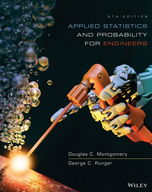Solution Found!
Suppose that X has a hypergeometric distribution with N =
Chapter 3, Problem 142E(choose chapter or problem)
Suppose that X has a hypergeometric distribution with N = 20, n = 4, and K = 4. Determine the following:
(a) \(P(X=1)\) (b) \(P(X=4)\)
(c) \(P(X \leq 2)\) (d) Mean and variance of X.
Equation transcription:
Text transcription:
P(X=1)
P(X=4)
P(X \leq 2)
Questions & Answers
QUESTION:
Suppose that X has a hypergeometric distribution with N = 20, n = 4, and K = 4. Determine the following:
(a) \(P(X=1)\) (b) \(P(X=4)\)
(c) \(P(X \leq 2)\) (d) Mean and variance of X.
Equation transcription:
Text transcription:
P(X=1)
P(X=4)
P(X \leq 2)
ANSWER:Step 1 of 6
Given,
Number of objects, $$N = 20$$
Objects classified as successes,$$ K = 4$$
The random variable X that equals the number of successes in the sample is a
hypergeometric random variable and the probability mass function is,
Where,$$ x = max\{0, n + K - N\}\ to\ min\ \{K,n\}$$
